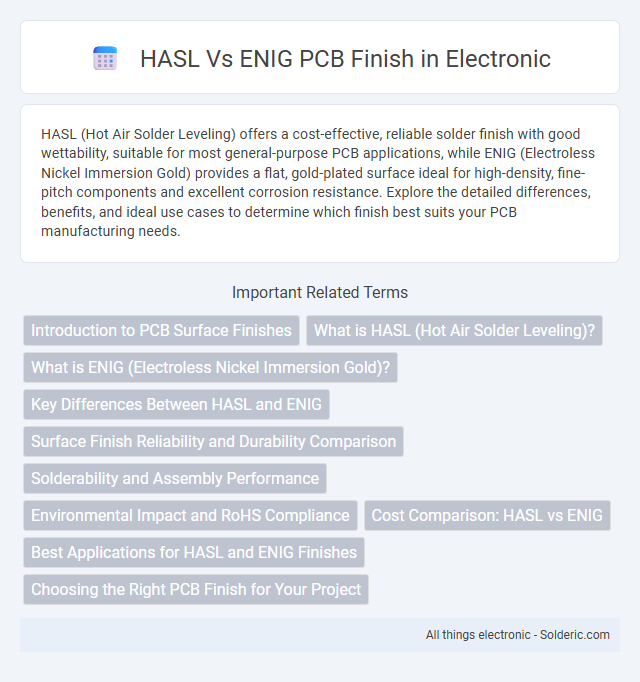HASL (Hot Air Solder Leveling) offers a cost-effective, reliable solder finish with good wettability, suitable for most general-purpose PCB applications, while ENIG (Electroless Nickel Immersion Gold) provides a flat, gold-plated surface ideal for high-density, fine-pitch components and excellent corrosion resistance. Explore the detailed differences, benefits, and ideal use cases to determine which finish best suits your PCB manufacturing needs.
Comparison Table
| Feature | HASL (Hot Air Solder Leveling) | ENIG (Electroless Nickel Immersion Gold) |
|---|---|---|
| Surface Composition | Tin-lead or lead-free solder coating | Nickel base layer with thin gold overlay |
| Flatness | Less flat, uneven surface | Highly flat and uniform surface |
| Suitability for Fine Pitch | Not ideal for fine pitch components | Excellent for fine pitch and BGA components |
| Durability | Moderate, susceptible to oxidation | High durability and oxidation resistance |
| Cost | Lower cost, economical for standard PCBs | Higher cost due to complex process |
| Solderability | Good solderability but decreases over time | Excellent and consistent solderability |
| Environmental Impact | Lead content in some HASL types (RoHS considerations) | Lead-free, RoHS compliant |
Introduction to PCB Surface Finishes
HASL (Hot Air Solder Leveling) and ENIG (Electroless Nickel Immersion Gold) are two common PCB surface finishes used to protect copper pads and ensure reliable solderability. HASL involves coating the PCB with molten solder, providing a cost-effective and robust finish, while ENIG offers a thin layer of nickel followed by gold plating, delivering excellent flatness and superior corrosion resistance ideal for fine-pitch components and high-frequency circuits. Choosing between HASL and ENIG depends on factors like component density, environmental durability, and budget constraints in PCB manufacturing.
What is HASL (Hot Air Solder Leveling)?
HASL (Hot Air Solder Leveling) is a popular PCB finish method where the board is dipped in molten solder, and excess solder is removed by hot air knives to create a uniform coating. This finish provides excellent solderability and is cost-effective, making it suitable for various electronic applications. HASL can be leaded or lead-free, impacting environmental compliance and performance in specific conditions.
What is ENIG (Electroless Nickel Immersion Gold)?
ENIG (Electroless Nickel Immersion Gold) is a PCB surface finish consisting of a nickel layer deposited chemically onto the copper trace, followed by a thin layer of immersion gold to protect the nickel from oxidation. This finish provides excellent solderability, flat surface, and long shelf life, making it ideal for fine-pitch and high-reliability applications. ENIG is preferred over HASL (Hot Air Solder Leveling) due to its superior planarity and better compatibility with surface mount technology (SMT).
Key Differences Between HASL and ENIG
HASL (Hot Air Solder Leveling) provides a thicker, more cost-effective finish ideal for through-hole components but can cause uneven surfaces impacting fine-pitch components. ENIG (Electroless Nickel Immersion Gold) offers a flat, thin, and highly reliable surface suitable for high-density PCB designs with excellent corrosion resistance and longer shelf life. When choosing your PCB finish, consider factors like budget, component type, and required surface flatness to ensure optimal solderability and performance.
Surface Finish Reliability and Durability Comparison
ENIG (Electroless Nickel Immersion Gold) provides superior surface finish reliability and durability compared to HASL (Hot Air Solder Leveling) due to its uniform gold layer that resists oxidation and ensures consistent solderability over time. HASL surfaces, prone to uneven coatings and thermal stress during application, may develop micro-cracks and reduced lifespan, impacting long-term performance. Understanding these differences helps you select the best finish to increase your PCB's operational resilience and maintain electrical integrity under harsh conditions.
Solderability and Assembly Performance
HASL (Hot Air Solder Leveling) PCB finish offers excellent solderability due to its thick solder coating, which ensures strong mechanical and electrical connections during assembly. ENIG (Electroless Nickel Immersion Gold) provides superior assembly performance with a flat, oxidation-resistant surface that supports fine-pitch components and consistent solder joint quality. Your choice between HASL and ENIG impacts solder joint reliability and overall manufacturing efficiency, especially in high-density or lead-free assembly processes.
Environmental Impact and RoHS Compliance
HASL (Hot Air Solder Leveling) PCB finish involves the use of lead-based solder, which raises environmental concerns due to lead toxicity and disposal challenges, making it less favorable for RoHS (Restriction of Hazardous Substances) compliance. ENIG (Electroless Nickel Immersion Gold) finish provides a lead-free alternative with excellent surface quality and longer shelf life, aligning better with RoHS standards by minimizing hazardous materials. Choosing ENIG for Your PCB finishes supports environmental sustainability and regulatory compliance for modern electronics manufacturing.
Cost Comparison: HASL vs ENIG
HASL (Hot Air Solder Leveling) offers a lower-cost PCB finish option compared to ENIG (Electroless Nickel Immersion Gold), making it suitable for budget-sensitive projects. ENIG provides superior surface planarity and better solderability but typically incurs higher fabrication costs due to its complex plating process and noble metal usage. Cost differences between HASL and ENIG can impact overall project budgets, especially in large-volume or high-reliability applications.
Best Applications for HASL and ENIG Finishes
HASL (Hot Air Solder Leveling) is best suited for prototyping and through-hole PCB applications due to its cost-effectiveness and excellent solderability. ENIG (Electroless Nickel Immersion Gold) offers superior surface planarity and corrosion resistance, making it ideal for high-density, fine-pitch components and lead-free assembly processes. ENIG finish is preferred in advanced electronics such as smartphones, aerospace, and automotive industries requiring reliable solder joints and extended shelf life.
Choosing the Right PCB Finish for Your Project
Choosing the right PCB finish is crucial for ensuring durability, solderability, and cost-effectiveness in your project. HASL (Hot Air Solder Leveling) offers excellent solderability and is budget-friendly but may cause issues with fine-pitch components due to uneven surfaces. ENIG (Electroless Nickel Immersion Gold) provides a flat, corrosion-resistant surface ideal for high-density and lead-free assembly, making it the preferred choice when long-term reliability and precise component placement are priorities.
HASL vs ENIG PCB finish Infographic

 solderic.com
solderic.com